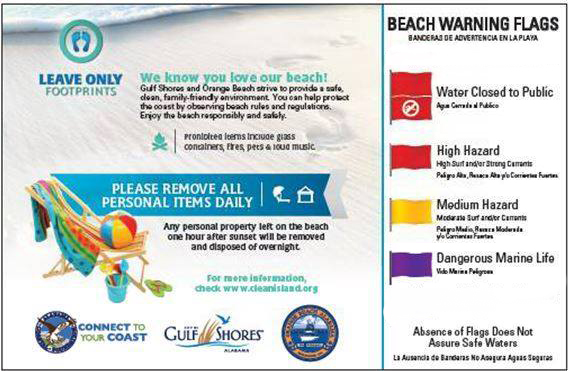Make your beach day one for the photo books by following safe practices for swimming, surfing and boating.
A dip in the Gulf of Mexico is the order of the day for most visitors. The call of the warm waves is too tempting to resist, but swimmers should know the flag colors before getting in the water. Most beach towns along the Gulf Coast, including Gulf Shores and Orange Beach, use the same warning flag system to give visitors a heads-up on beach conditions.
- Yellow flags warn swimmers there are medium hazards with moderate surf and/or currents.
- A red flag cautions swimmers of highly hazardous conditions caused by high surf and/or strong currents.
- A purple flag means there is dangerous marine life in the Gulf waters. Purple flags may fly with another color flag; be sure to heed both.
- Double red flags mean the water is closed to the public. These sorts of conditions usually happen during severe storms or hurricanes.
Swimmers should also be cautious of riptides – narrow channels of water flowing out past the surf zone. They can pull even strong swimmers into deep water beyond the offshore sand bar. The most important thing to do when caught in a ripcurrent is to stay calm. Try to escape it by swimming parallel to the shore because the ripcurrent is very narrow. If you cannot swim parallel to the shore, lie on your back and float out to where the ripcurrent ends or weakens. Swim back to shore at an angle, away from the ripcurrent.
 Surfing Safely
Surfing Safely
Much of the surfing information available has to do with where to find the best swells along the Alabama Gulf Coast. While waves of Pacific proportions are not going to be present on the Gulf Coast, there are decent waves to ride.
Jellyfish are the biggest problem for surfers in Gulf Shores and Orange Beach. Stingrays can be avoided fairly easily by either keeping your feet off of the sand or dragging your feet along it.
Boating Safety
Boating safety is in your hands, literally. Outdoor Alabama, a division of the Alabama Department of Conservation & Natural Resources, offers several tips to keep you safe on the water, and most involve planning ahead for the what-ifs.
- All life jackets should be in good working order. In the event of declining weather, insist that everyone on the boat is wearing his/her life jacket.
- Make sure all of your safety equipment is on the boat.
- Be sure your boat is in good working order – check the belts, fluids and motors to avoid having to be towed back to the dock.
- Keep an eye on the weather and learn what to do if a storm prevents you from reaching safe shelter.
- Learn the rules of boating. If you plan to operate a boat in Alabama, you must have your boating license. Classes are held around the state to get you prepared for the exam.
- Drive defensively. People don’t always give the right-of-way, even when they should.
- Don’t drink and drive on the water (or on land). There are penalties for Boating Under the Influence. The legal limit for blood alcohol content is 0.08 percent.



Thanks for reminding me that all lifeboats should be checked and see if they are in good working order. We want to celebrate our parents’ 30th wedding anniversary and thought that it would be nice to try something new. We’ll definitely prioritize our safety as we try to find a place where we can rent a private boat charter for our family.